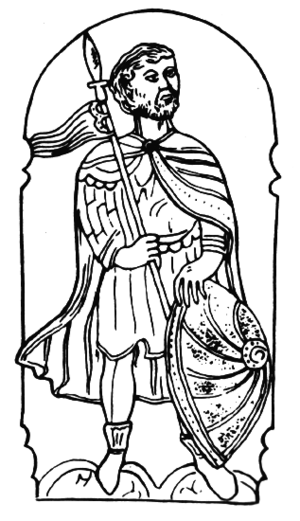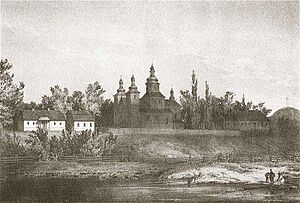Vaišvilkas facts for kids
Quick facts for kids Vaišvilkas |
|
|---|---|

16th–17th century imaginative depiction of Vaišvilkas
|
|
| Grand Duke of Lithuania | |
| Reign | 1264–1267 |
| Predecessor | Treniota |
| Successor | Shvarn |
| Duke of Novogrudok | |
| Reign | 1253–1254 1258–1259 |
| Successor | Roman Danylovych |
| Born | 1223 |
| Died | 1267 |
| House | Mindaug |
| Father | Mindaugas |
Vaišvilkas, also known as Vaišelga, was an important leader in Lithuania a long time ago. He was the Grand Duke of Lithuania, which means he was like the main ruler, from 1264 until he passed away in 1267. Vaišvilkas was the son of Mindaugas, who was the first and only Christian King of Lithuania.
Contents
What's in a Name?
Historians and language experts have studied Vaišvilkas's name for a long time. They have found two main ways to say his original Lithuanian name: Vaišvilkas and Vaišelga.
The first part of his name, vaiš-, is clear and found in many old names. But the second part, -vilkas, which means "wolf", is very rare in Lithuanian names. This makes some experts think his name might have been Vaišvilas originally.
The name Vaišelga (or Vaišalga) is also very popular among historians. However, the meaning of the -alg or -elg part is not fully clear. Some researchers even think he might have had two names, with one of them being Vaišvilas.
The Story of Vaišvilkas
We don't know much about Vaišvilkas's early life. He first appears in history in 1254. At that time, he helped his father, King Mindaugas, make an important agreement with Daniel of Halych, a ruler from a place called Halych-Volhynia.
Becoming a Monk
As part of the agreement, Halych-Volhynia gave a region called Black Ruthenia, with its main city Navahrudak, to Lithuania. To make the agreement stronger, Daniel's son, Shvarn, married Vaišvilkas's sister. Vaišvilkas was then made the duke, or ruler, of some of these new lands.
Vaišvilkas became a Christian through the Greek Orthodox Church. He became very interested in religious life. So much so that he gave up his title and lands to Roman Danylovich, another son of Daniel of Halych.
He then started a monastery, which is a place where monks live and pray. This monastery is believed to be the Lavrashev Monastery, located by the Neman River. Vaišvilkas became a monk there. He even began a long journey to Mount Athos in Greece, a very holy place. But because of wars, he couldn't reach it and returned to Navahrudak.
Returning to Power
In 1264, Vaišvilkas faced a dangerous situation. There was a plan to kill his father, King Mindaugas, and his two brothers. The plot was led by Treniota and Daumantas of Pskov. Vaišvilkas managed to escape this danger.
Later, Treniota was killed by people who used to work for Mindaugas. Vaišvilkas then teamed up with his brother-in-law, Shvarn, from Halych-Volhynia. Together, they took control of Black Ruthenia and the main part of the Duchy of Lithuania.
They then fought against Nalšia and Deltuva. These were areas that had opposed Mindaugas and Vaišvilkas. Daumantas, the duke of Nalšia, had to run away to Pskov. Another important duke from Nalšia, named Suksė, also fled to Livonia.
After these events, Vaišvilkas became the next Grand Duke of Lithuania. Because he was a Christian, he wanted to be friends with the Teutonic Knights and the Livonian Order. These were powerful groups of knights.
He signed a peace agreement with Livonia about trading on the Daugava River. Lithuania also stopped supporting the Great Prussian Uprising, which was a rebellion against the knights. This allowed the knights to continue their actions against the Semigallians and Curonians without interruption. In 1265, Vaišvilkas and Shvarn attacked Poland. This was to get revenge for a defeat that the Yotvingians had suffered the year before.
Later Years and Death
In 1267, Vaišvilkas decided to return to his life as a monk. He gave his title of Grand Duke to Shvarn. However, a year later, he was killed by Shvarn's brother, Leo I of Halych. Leo was angry because Vaišvilkas had not shared power between him and his brother. Vaišvilkas was buried near the Assumption Church in Volodymyr.
See also
- House of Mindaugas – Learn more about Vaišvilkas's family tree
- List of Lithuanian rulers – See a list of other Lithuanian leaders


